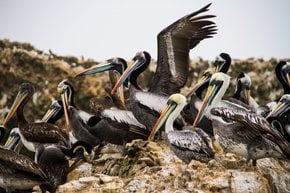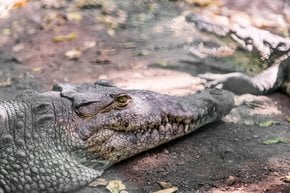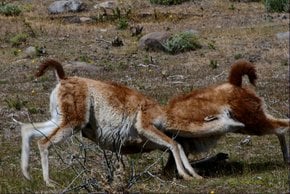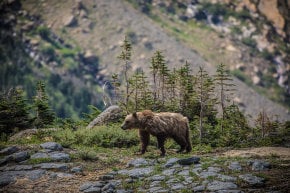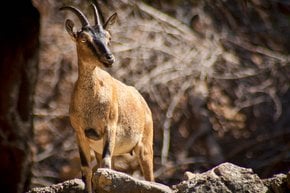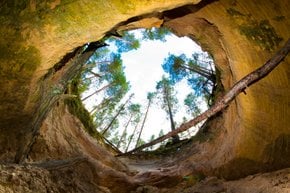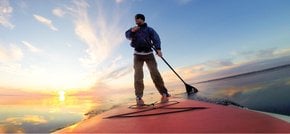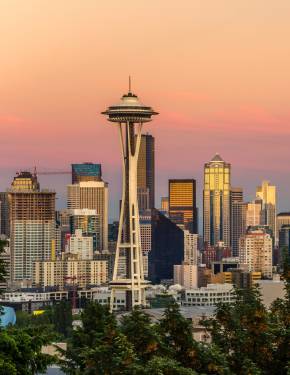Whale Watching near Olympic National Park 2026
Few experiences compare to catching a glimpse of some of the largest mammals on earth
Best time: April–May | October–November
To be near an animal that can grow to 30 or 40 tons brings a rare perspective on life and is truly unforgettable. Few places in the US are more conducive to whale watching than the west coast of the Olympic Peninsula and the Salish Sea. This area offers unbeatable land-viewing and boating opportunities to get close to these marine giants.
Best Places for Whale Watching
Although whales can be spotted nearly anywhere along the Olympic coast, several areas are perfect for catching a glimpse of these giant marine mammals. May is designated whale watching month at Kalaloch Lodge, which is part of the Whale Trail, a collection of over 100 viewing locations that extends from British Columbia southbound to California. For the best land viewing opportunities, explore the shores of Second Beach, Rialto, Shi Shi, or Neah Bay, but be sure to plan before you go, as some places are currently closed to visitors.
Other locations that offer a great viewing platform for whales can be found either in the Salish Sea or the Pacific Ocean are the Dungeness National Wildlife Refuge, Tongue Point Marine Life Sanctuary (also known as Salt Creek Recreation Area), Ruby Beach, or Haynisisoos Park. So bring a chair and binoculars and find your spot anywhere along the Olympic Peninsula's 73-mile (117.5 km) of public coastline.
Admission & Hours in Olympic National Park
If you plan to try to spot a whale from the coast of Olympic National Park, it's important to remember that entry to its grounds requires a pass. Standard one-day entrance costs $15 per person, $25 per motorcycle, and $30 per vehicle. An annual entrance pass costs $55. The park is open year-round, but some facilities might be closed from October through May.
Whale Watching Tours
There are almost countless options for whale-watching tours, ranging from large outfitters to smaller boats for a quieter experience. We have picked a few of the best options to get you started.
Puget Sound
If you are departing from Seattle/Edmonds, Port Angeles, or Port Townsend, the Puget Sound Express is one of your best options for a tour by boat. Their tours vary in length depending on which tour you take. Their fleet of four boats will accommodate your needs and allow you to fully enjoy your experience on the water. Several of their vessels are even equipped with a hydrophone, allowing passengers to hear the whales talking underwater. The tour season lasts through April into October, with additional tours in November-December.
Expect to spend anywhere from 2-5 hours aboard during half-day tours, and around 8 hours at full-day tours. These tours will cost you between $115-$165 per adult or $85-$125 for children (2-10). Anyone younger than 2 gets a free ride! A major draw to taking a tour with the Puget Sound Express is their guarantee to see a whale, or they will give you a voucher for a free ride. For those who have yet to find their sea legs, the Port Townsend Marine Science Center offers educational events and exhibits for land lovers.
Anacortes
Another boat tour outfitter that offers guaranteed whale sightings is Island Adventures Whale Watching Company. Tours depart from Anacortes between February and November from Cap Sante Marina. Each boat offers indoor heated cabins, viewing decks, onboard naturalists, concessions, and restrooms to make your experience a memorable one.
Depending on the tour you select, you might be on the water for 4-5 hours. Although discounts may be available, the tickets generally cost $109-119 for adults and $69-79 for children ages 2 to 12. Pass for children under one costs $1. The tours normally depart at 10-11 am, with additional races at 3:30 pm during peak season.
Season to See Whales
Whale-watching tours in the Salish Sea typically follow the migration patterns of several whale species as they switch from their rich northern waters used for feeding to their warmer, shallower, and safer calving grounds, such as the Sea of Cortez in Mexico's Baja peninsula.
Find these massive creatures on their biannual journey past the Pacific Northwest either between April and May or October and November. You might also see some of the incredible flora and fauna of the area such as eagles or other sea mammals like seals, otters, or porpoises.
Bigg's Killer Whales (all-year)
One of the whale species you are likely to spot is the Bigg's killer whale (Orcinus orca), also known as an orca whale. They use these waters to hunt and feed together. These whales travel in family groups of 4 to 7, and it is estimated that there are over 400 individuals that feed year-round in the Salish Sea. Unlike some of the other whale species you might glimpse here, these whales do not migrate seasonally.
Gray Whale (spring, fall)
Gray whales (Eschrichtius robustus) are known to have the longest migration route of any mammal. They tirelessly cover 10,000 to 14,000 mi (16,093 to 22,531 km) every year, traveling from Alaska to Mexico and back again. Their journey north takes place in late March-May, while southward migration normally happens in October and November. These noble underwater beasts make a stop to feed and refuel in the Salish Sea between Vancouver Island and the Olympic Peninsula. During late spring and summer, gray whales can be spotted feeding at the rivers of the park.
Humpback Whale (spring, fall)
One of the most recognized whale species that is found all around the world is the humpback whale (Megaptera novaeangliae). Known as one of the largest mammals on earth, this animal was nearly hunted to extinction. Despite legal protection and conservation efforts throughout the globe, this species has come back from the brink to be viewed and appreciated from a distance. It's truly a wonderful experience to be able to observe such a majestic creature.
Minke Whale
Of all the whales that frequent this area, the Minke (pronounced mink-ee) whale (Balaenoptera acutorostrata) is the toughest to view. Because of their feeding habits and shy nature, these cetaceans aren't frequently seen, nor is much known about their migration habits. Try your luck on a cruise to witness a whale that few humans get a chance to spot.
Whale Watching Tips
Spending time on a beach or in a boat can expose you to unpredictable weather. In the rainy and sometimes foggy Pacific Northwest, prepare for strong winds, high tides, and unfavorable weather conditions.
What to Wear
Be sure to dress for the occasion with several layers to keep warm and insulate yourself for protection against wind and rain. Although most tours offer sheltered viewing locations, having a rain jacket is a good idea. Temperatures drop significantly once you're out in the ocean, so wearing warm clothing is important, even during seemingly warm weather. On sunny days, be sure to use sunscreen, as water can reflect the sun's rays, increasing the chances of sunburn. Tour operators recommend wearing comfortable, closed-toe shoes and refrain from wearing high heels or slippers.
What to Bring
Come prepared with snacks and drinks to keep you energized for several hours cruising on a boat. Some vessels offer a snack bar and concessions to keep you from going hungry. To get a better view of the wildlife you may encounter, binoculars or a camera with a zoom lens are a great idea. Unfortunately, pets are not allowed on board due to safety reasons, but if you have a service animal, consider contacting your tour operator, as service animals are allowed.
Where to Stay
The Olympic peninsula is a popular tourist destination and, as such, hosts a great selection of hotels, campgrounds, bed and breakfasts, and Airbnb's. For a cozy stay out on the coast of the Pacific, check out Kalaloch Lodge. For something a bit more rustic, check out one of the many campgrounds located within the park.














